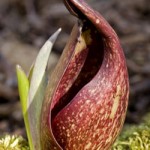By Amy O’Donnell
 What is reddish-brown, smells rotten and attracts flies? The skunk cabbage flower, of course.
What is reddish-brown, smells rotten and attracts flies? The skunk cabbage flower, of course.
Crocuses aren’t the only flower poking their heads through the ice-packed soil as the season begins to warm. A walk along a swampy path in early March and you may spy a teardrop shaped chamber, speckled maroon and brown emerging from the muddy soil. This is the reproductive structure or flower of the skunk cabbage, a plant whose large bouquet of leaves dots the soft edges of swamps from Nova Scotia to Tennessee.
Skunk cabbage is an apropos name. This plant is a stinker, but once you have embraced its fetid odor as part of the plant’s appeal, you can begin to appreciate the suite of adaptations that allow Skunk Cabbage to burst on to the scene earlier than other flowering plants.
What are its challenges? First there is the temperature. Early spring is unpredictable but usually damp and chilly and sometimes even snowy, not the weather that favors flowers and pollinators. Skunk cabbage has not only adapted to the frosty temperatures but has even figured out a way to exploit this environmental condition to its advantage. Skunk cabbage uses a process called uncoupled respiration to create heat. This heat allows the plant to create a microclimate inside and around its flower some 20 degrees warmer than the ambient temperature.
Scientists believe this heat helps the plant in several ways. Warming the soil and air around the plant, the flower can melt away icy barriers and warmer localized air helps volatilize or disperse the chemical signals released by the flower. The heat also creates a welcoming environment for pollinators who are encouraged to linger in the warm sheltering flower.
This, of course, leads to the next biggest challenge which is attracting a pollinator when so few insects are around.Skunk cabbage has multiple adaptations dedicated to overcoming this obstacle. The flower’s scent is putrid to us but smells wonderful to flies, the target of this flower’s design. The shape, color and perfume of this flower work in concert to lure flies to a ‘dead body.’ Skunk cabbage is a member of the arum family, a group known for extravagant flowers designed to mimic rotting flesh. So let’s revisit the colors of this flower, a reddish brown mottled pattern, in keeping with the illusion of a fresh kill.
The skunk cabbage ‘flower’ is actually an inflorescence (group of flowers) made of many small male and female flowers organized on the spadix or stalk inside the spathe, a hood-like structure that is really a modified bract. Together, the spathe and spadix create a chamber for the pollen to be exchanged. Transient flies enter into the warm inside of the flower directed by color patterns and powerful smells. Once inside they are likely to pick up or drop off pollen so the plant can reproduce.
Skunk Cabbage is deciduous perennialso its leaves die back in the fall. Now that the winter is winding down, be on the look out for this amazing plant on your walks around the ponds in town. Hold your nose and happy hunting.
Thank you to Dr. Eric Roberts, Associate Professor of Biology at Rhode Island College for his vast knowledge of plants and his input in writing this article.
